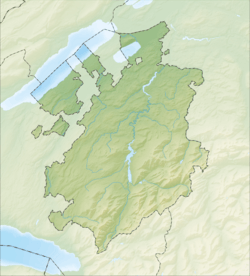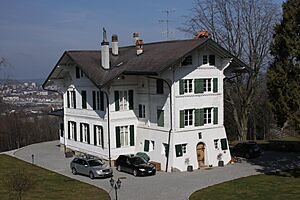Pierrafortscha facts for kids
Quick facts for kids
Pierrafortscha
|
||
|---|---|---|
|
||
| Country | Switzerland | |
| Canton | Fribourg | |
| District | Sarine | |
| Area | ||
| • Total | 5.06 km2 (1.95 sq mi) | |
| Elevation | 751 m (2,464 ft) | |
| Population
(Dec 2020 )
|
||
| • Total | 157 | |
| • Density | 31.03/km2 (80.4/sq mi) | |
| Postal code |
1723
|
|
| Surrounded by | Fribourg (Fribourg/Freiburg im Üechtland), Marly, Sankt Ursen, Tentlingen, Villarsel-sur-Marly | |
Pierrafortscha is a small town, also called a municipality, located in the Sarine district of Switzerland. It's part of the Fribourg canton. The name Pierrafortscha means "forked rock" in the local Fribourg dialect.
History of Pierrafortscha
Pierrafortscha was first mentioned in old records in the year 1267. Back then, it was called Pierraforchia. A few years later, in 1277, it was known as Bevrechie.
For a while, the town also had a German name, Perfetschied. However, people don't use that name anymore.
Geography and Landscape
Pierrafortscha covers an area of about 5.1 square kilometers (2 square miles). A large part of this land, almost 70%, is used for farming. About 22% of the area is covered by forests.
The town also has buildings and roads, which make up about 7% of the land. A small part, less than 1%, includes rivers and lakes.
Land Use Details
Most of the built-up areas are homes and other buildings. Roads and transportation paths make up a smaller part. In the forests, about 20% of the land is dense forest. Another small part has orchards or groups of trees.
For farming, nearly half of the land is used for growing crops. The rest is used as pastures for animals. The water in the municipality comes from small lakes and rivers.
Hamlets of Pierrafortscha
Pierrafortscha is located near the Saane/Sarine river and the Gérine river. It sits right on the border where French and German are spoken. The municipality is made up of eight smaller villages, called hamlets. These include Pierrafortscha itself, Villars-sur-Marly, Granges-sur-Marly, and La Schürra.
Coat of Arms
Every town has a special symbol called a coat of arms. Pierrafortscha's coat of arms shows a rough stone. The background is divided into two parts: the top is blue, and the bottom is gold.
Population and People
Pierrafortscha has a population of 157 people. About 10% of the people living here are from other countries. Over the last ten years, the population has grown by about 8.6%.
Languages Spoken
Most people in Pierrafortscha speak French as their main language. About 70% of the residents speak French. German is the second most common language, spoken by about 28% of the people. A small number of people also speak Italian.
Who Lives in Pierrafortscha?
In Pierrafortscha, the population is almost evenly split between males and females. About 49% are male, and 51% are female. Most residents are Swiss citizens.
About one-third of the people living in Pierrafortscha were born there. Many others were born in the same canton (region) of Fribourg. Some people moved here from other parts of Switzerland or from other countries.
Age Groups
Young people, including children and teenagers (up to 19 years old), make up about 21% of the population. Adults (20 to 64 years old) are the largest group, making up about 63%. Seniors (over 64 years old) make up about 15% of the population.
Households
There are about 56 private homes in Pierrafortscha. On average, about 2.4 people live in each home. Some homes have only one person, while others have five or more people. Almost all apartments in the municipality are lived in permanently.
Important Heritage Sites
Pierrafortscha has two special buildings that are considered very important to Switzerland's history and culture. These are the Chalet de Diesbach and the old granary of Château d’En-Haut. They are listed as Swiss heritage sites of national importance.
Also, two of the hamlets, Granges-sur-Marly and Villars-sur-Marly, are part of the Inventory of Swiss Heritage Sites. This means they have special historical value.
Economy and Jobs
In 2010, Pierrafortscha had a low unemployment rate, meaning most people who wanted to work had jobs. Many people work in the primary economic sector, which includes farming. There are about 10 businesses related to farming.
Some people also work in the secondary sector, which involves making things, like in factories. A smaller number of people work in the tertiary sector, which includes services, like technical jobs.
Working Life
In 2008, there were 41 full-time jobs in Pierrafortscha. Most of these jobs were in agriculture. Some jobs were in manufacturing. A few jobs were in the service industry, often for professionals or scientists.
Many people who live in Pierrafortscha travel to other towns for work. Only a few people come into Pierrafortscha to work. Most people use a private car to get to their jobs. A small number use public transportation.
Religion
According to a census from 2000, most people in Pierrafortscha are Roman Catholic. About 72% of the population belongs to the Roman Catholic Church. The second largest group, about 23%, belongs to the Swiss Reformed Church. A small number of people do not belong to any church.
Education
In Pierrafortscha, many adults have completed a good level of education. About 34% of the population has finished upper secondary education, which is like high school. About 17% have gone on to higher education, such as a university or a specialized college.
Swiss School System
The school system in the Canton of Fribourg starts with one year of optional Kindergarten. After that, students go to six years of Primary school. Then, they attend three years of mandatory lower Secondary school. In this stage, students are grouped based on their abilities.
After lower Secondary school, students can choose to go to an optional upper Secondary school for three or four years. This can be a gymnasium, which prepares them for university, or a vocational program for specific job skills. After upper Secondary, students can go to a higher education school or start an apprenticeship.
Students in Pierrafortscha
During the 2010-2011 school year, no students were attending school directly in Pierrafortscha. However, 21 students from Pierrafortscha went to schools in other towns. Most of these students were in primary school. Some were in mandatory secondary school or vocational programs.
See also
 In Spanish: Pierrafortscha para niños
In Spanish: Pierrafortscha para niños






